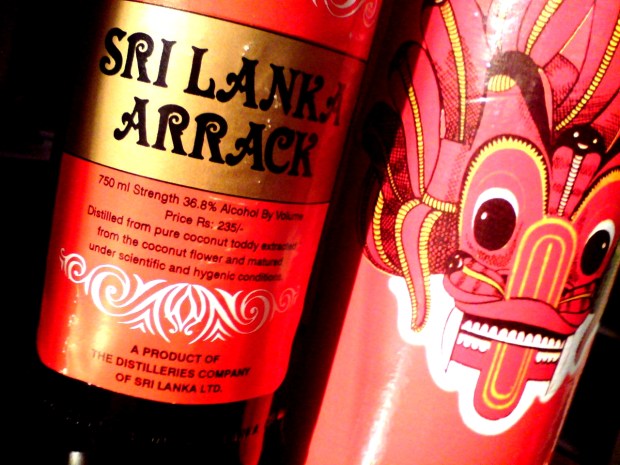I was first introduced to arrack a few years ago, when it fueled the final hours of a childhood friend’s wedding reception. Sri Lanka’s signature spirit is usually strong and dark; it’s a little sweet, not unlike a marriage of bourbon and rum, but with a stronger, burning kick and a mysterious bouquet.
Arrack is made from only two ingredients: water and the distilled sap of unopened coconut flowers from the Sri Lankan coconut palm. (Sri Lankan arrack, by the way, is not the same as arak, the anise-based drink popular in the Mediterranean and North Africa, and it’s not Batavia arrack, the Indonesian spirit distilled from sugarcane and red rice.)
The tall, dignified coconut palm is one of Sri Lanka’s enduring visual motifs, but it’s also a foundation of life there. All of its parts find a use: the trunk, leaves, and coconut shells make boats, roofs, fishing rods; coconut innards yield nutritious water, the milk and vinegar that fuels countless Sri Lankan dishes, and stronger libations—the younger coconut moonshine called toddy and the aged, refined arrack.

In the mornings during the tapping or harvesting season—April to December—“toddy tappers” climb coconut palms armed with a special knife and gourd. Once up there, a daring 50 feet above the ground, they move between palms on tightropes, preparing new spathes by cutting off the tips of unopened coconut flowers or painstakingly collecting the sweet sap, which rapidly ferments into the mildly alcoholic, palm wine–like toddy, itself a popular tipple. (Look out for improvised cardboard signs for toddy on rural roads.)
Toddy tappers often have agreements with arrack distilleries to deliver a certain amount of the raw coconut booze; others sell their haul more informally. It’s also a dying trade—dangerous work for low pay that is now divided among fewer and fewer coconut trees as nature is cleared for housing developments.
Toddy destined for arrack is put in timber vats, then copper stills, where it ends up at around 50 percent alcohol by volume (ABV) within only 24 hours. At that point, many kinds of arrack are left to age for years.
Sri Lankans tapped coconut wine more than 2,000 years ago. Although we don’t know exactly when arrack was first made, it is one of the oldest distilled spirits in the world—far older even than Scotch whisky. A British explorer noted in 1859 that visiting Arab traders drank this “exhilarating” spirit in the 5th century.
Now there are a couple dozen companies in Sri Lanka producing arrack, and a few export it to the U.S and U.K. People drink it neat, on the rocks, with coconut water, or as a stand-in for whiskey-based cocktails—but the most popular mix might be arrack and ginger beer, sometimes with a dash of lime. (If you want to bring a haul of arrack back home, check the bottle’s label: The premium kind is pure arrack, but many versions are blended with other spirits and can contain as little as 3 percent arrack. Some are made with molasses. The drinkability of the blended versions varies wildly.)
When I go to Sri Lanka, whether for travel or reporting trips, arrack is my sundowner drink. I acquired the taste after various post-dinner drinks while a few of us went traveling together after the wedding on that first trip. We drank arrack after climbing the ancient rock palace Sigiriya; at sunset at Kandalama, the surreal Geoffrey Bawa-designed hotel that, by design, the jungle reclaims bit by bit each year; and after a rainy day wandering the streets of the fortress town Galle. When I returned for reporting trips in Jaffna, it rounded off my first dinner on solid ground after a long, rickety train trip from Colombo. Perhaps most memorably, I once drank a glass at Queen’s Hotel in Kandy, then hosting part of the Galle Literary Festival, as author Sebastian Faulks sipped his drink quietly a few bar stools down from me.
The coconut gives arrack a distinctive, manageable sweetness—a flavor element I now miss when I drink bourbon, rye, or whiskey. After that first trip, I brought back two bottles to London. At first my roommates politely informed me that it was an acquired taste, but they acquired it themselves soon enough. The bottles didn’t last long.